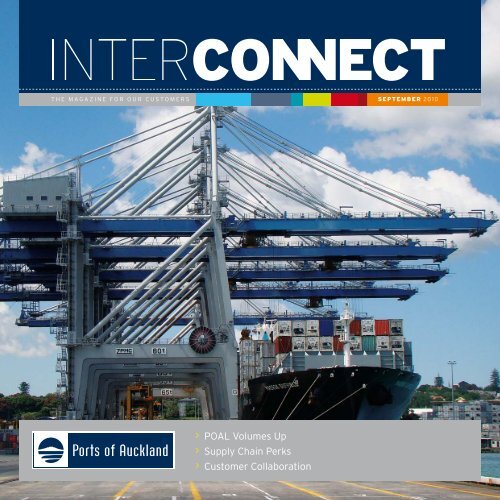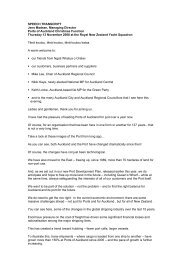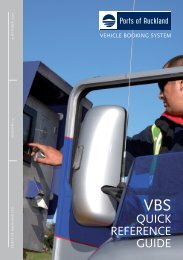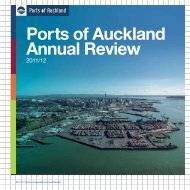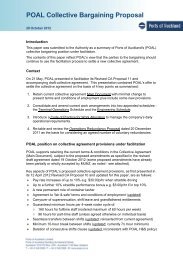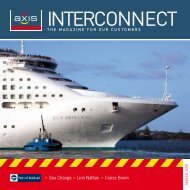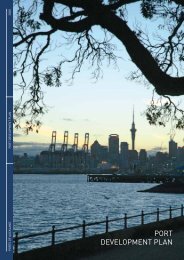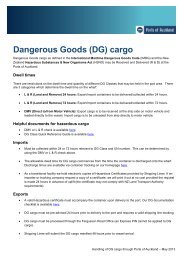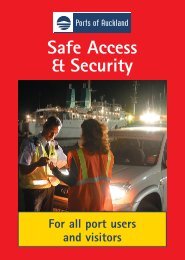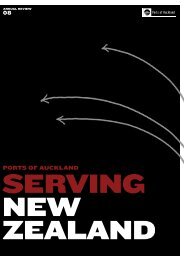ONE - Ports of Auckland
ONE - Ports of Auckland
ONE - Ports of Auckland
Create successful ePaper yourself
Turn your PDF publications into a flip-book with our unique Google optimized e-Paper software.
T H E M A G A Z I N E F O R O U R C U S T O M E R S SEPTEMBER 20 1 0<br />
> POAL Volumes Up<br />
> Supply Chain Perks<br />
> Customer Collaboration
CONTENTS POAL<br />
2-3<br />
POAL<br />
FOCUS<br />
8-9<br />
CONLINXX<br />
SUPPLy CHAIN<br />
EFFICIENCy<br />
4-5<br />
OPERATIONS<br />
REVIEW<br />
ExPANSION & UPGRAdES<br />
FOR POAL SeaPACK<br />
& EMPTy dEPOT<br />
14-15<br />
MARKET<br />
ROUND UP<br />
SEPTEMbER 2010<br />
10-11<br />
POAL<br />
NEWS<br />
12-13<br />
AS THEY<br />
SEE IT:<br />
wHAT THE<br />
PAPERS SAy…<br />
BACK<br />
PAGE<br />
DIRECTORY<br />
6-7<br />
FACE TO FACE:<br />
STUART FERGUSON<br />
LOOKS bACK – ANd<br />
FORwARd<br />
FOCUS<br />
CRAIG SAIN<br />
GENERAL<br />
MANAGER<br />
SALES &<br />
MARKETING<br />
PORTS OF<br />
AUCKLAND<br />
VOLUMES UP<br />
wE STARTEd OUR LAST<br />
FINANCIAL yEAR JULy<br />
2009 IN A STATE OF<br />
UNCERTAINTy AbOUT<br />
VOLUMES. IN FACT, AS THE<br />
ENd OF FINANCIAL yEAR<br />
2009/10 RESULTS SHOw<br />
(SEE PGS 14-15), POAL<br />
ACHIEVEd VERy GOOd<br />
VOLUMES PARTICULARLy<br />
GIVEN THE GLObAL<br />
ECONOMIC CRISIS.
The result was largely due to some<br />
shipping service changes – including the<br />
consolidation <strong>of</strong> the North Asia service<br />
by Hamburg Sud, COSCo, MOL and NyK<br />
which based its import call on POAL from<br />
July 2009. That decision was a pleasing<br />
confirmation <strong>of</strong> the lines’ faith in POAL as<br />
an optimal NZ location for import cargo.<br />
Our Christmas peak volumes were also<br />
much higher than expected by our<br />
customers and ourselves. while all <strong>of</strong> us<br />
anticipated a short, sharp peak, we were<br />
surprised by a bow wave <strong>of</strong> volume that<br />
continued to surge through a much longer<br />
than expected Christmas/New year peak<br />
season.<br />
MARKET JITTERS<br />
despite that, the market remained jittery in<br />
the face <strong>of</strong> continued uncertainty around the<br />
longevity and sustainability <strong>of</strong> the volume.<br />
The consolidation <strong>of</strong> shipping lines leading<br />
to fewer services, reduced vessel numbers<br />
but larger ships, brought larger and ‘lumpier’<br />
exchanges. both the lines and POAL have<br />
struggled with schedule integrity. At POAL<br />
we’ve suffered the effects <strong>of</strong> the delays our<br />
customers have experienced in Asia. Add<br />
to that the increased use <strong>of</strong> slow steaming<br />
for lines to save fuel costs, and we see a<br />
picture <strong>of</strong> difficult instability in schedules all<br />
<strong>of</strong> which puts greater pressure on the port<br />
operation.<br />
For our part that uncertainty made us<br />
cautious – perhaps overly so. It was difficult<br />
to achieve a balance since there was<br />
volatility in volume from week to week and<br />
month to month. In the final analysis it<br />
meant that operationally we were stretched.<br />
we recognise the need to build more<br />
flexibility into our labour model and plant<br />
availability to cater for the inevitable vessel<br />
delays, increased exchanges and one-<strong>of</strong>f<br />
events such as vessel swaps or extra-loaders.<br />
Right now we are putting mechanisms in<br />
place which we are confident will enable us<br />
to deliver a more consistent performance<br />
moving forward.<br />
CUSTOMER COLLAbORATION<br />
This is however, a major challenge since<br />
the market these days in our container<br />
terminal business remains volatile. what we<br />
are now hoping for, is increasing stability in<br />
the market – a little more certainty around<br />
forecast volume and better schedule<br />
integrity. Reports indicate continued volume<br />
growth in the market. However, we have to<br />
set that against some capacity reduction<br />
particularly southbound. with the imminent<br />
approach <strong>of</strong> the peak season, that is likely<br />
to mean the introduction <strong>of</strong> extra loaders by<br />
some lines to cater for additional volume.<br />
They in turn, can once again exacerbate the<br />
‘lumpy’ exchange problem we had last year.<br />
we recognise that in such a volatile<br />
market our customers need a higher level<br />
<strong>of</strong> flexibility in our service response. but<br />
planning is key to the efficiency <strong>of</strong> our<br />
service delivery and to properly plan we<br />
need information and as early as possible!<br />
To make sure we get that information we are<br />
determined to continue to engage closely<br />
with our customers to get a clear grasp <strong>of</strong><br />
their business and cargo flows so that we<br />
can prepare to the best <strong>of</strong> our ability, to<br />
service those exchanges efficiently.<br />
On the flip side, we hope too that in this<br />
closer working relationship, our customers<br />
come to understand that an efficient<br />
POAL operation and service hinges largely<br />
on interaction with our customers and<br />
especially on, information received from<br />
them.<br />
Alongside our new web product<br />
developments like InterACT and changes<br />
to our business processes, we have also<br />
established business reference groups<br />
which enable us to lift the level <strong>of</strong><br />
collaboration with all stake holders in the<br />
Supply Chain. This continues to be a key<br />
focus for us<br />
Information is a very important part <strong>of</strong> an<br />
efficient Supply Chain. It is a well known<br />
principle that when people have the<br />
information they need, they can do the job<br />
better – and if everyone in the chain does<br />
their part correctly, the whole process<br />
comes together.<br />
03
OPERATIONS<br />
REVIEW:<br />
SeaPACK<br />
POAL’S ON-DOCK<br />
PACK/UNPACK<br />
BRINGS SUPPLY<br />
CHAIN PERKS FOR<br />
BOTH EXPORTERS<br />
AND IMPORTERS.<br />
Among many changes and upgrades continuing<br />
at <strong>Ports</strong> <strong>of</strong> <strong>Auckland</strong>, the specialist on-wharf<br />
Pack/Unpack service SeaPACK, has been<br />
given a major facelift and relocated to purposedesigned<br />
premises adjacent to the original<br />
central port location. SeaPACK Operations<br />
Manager Grange Pole, reports a smooth<br />
transition to the new facility which is wider<br />
and much lighter and brings better utilisation<br />
<strong>of</strong> space. New entry/exit roads have been<br />
established for the efficient flow <strong>of</strong> trucks to and<br />
from the facility.<br />
SEPTEMbER 2010<br />
SeaPACK provides export packing and<br />
consolidation services for a wide range <strong>of</strong><br />
products from timber and paper to steel,<br />
cars, swimming pools – even helicopters<br />
– along with palletised and hand-stacked<br />
general cargo. On the import side, a diverse<br />
range <strong>of</strong> goods are devanned or partially<br />
devanned taking at least one leg out <strong>of</strong> the<br />
Supply Chain for importers. An on-wharf<br />
Empty depot provides an efficient source <strong>of</strong><br />
Empty containers for packing and for de-hire.<br />
“At SeaPACK we can handle pretty much<br />
anything” says Paul bassett, Operations<br />
Supervisor.<br />
According to SeaPACK Sales Manager,<br />
yvonne Theuerkauf, customers rate SeaPACK<br />
very highly. “They value the high degree <strong>of</strong><br />
expertise our staff bring to the handling <strong>of</strong><br />
their cargo. we have a high level <strong>of</strong> repeat<br />
business which is a reflection <strong>of</strong> customers’<br />
appreciation <strong>of</strong> the quality service standard. A<br />
recent customer survey scored SeaPACK very<br />
highly for service efficiency and for the Supply<br />
Chain advantages it brings as an on-wharf<br />
pack and unpack service” she says.<br />
Another important advance for SeaPACK<br />
is the recent introduction <strong>of</strong> the service’s<br />
very own SeaPACK E-Note. As Grange Pole<br />
explains: “It’s a clear, concise and reliable<br />
format that enables much improved reporting,<br />
better planning and scheduling with a much<br />
higher level <strong>of</strong> transparency in the information<br />
flow. Our customers are really appreciating<br />
this new electronic service”. One such<br />
customer – Lisa berry, Operations Manager<br />
for Transport Logistics – describes the new<br />
E-Note as:<br />
“A SIMPLE, USER-FRIENdLy SySTEM THAT<br />
ALLOwS US TO ENTER ALL RELEVANT<br />
INFORMATION FOR CONTAINER<br />
PACKING. CONFIRMATION ANd CARTERS’<br />
NOTES ARE EMAILEd bACK TO US<br />
AUTOMATICALLy – IT’S REALLy HELPFUL<br />
TO HAVE SUCH CLEAR, CONCISE<br />
dOCUMENTS TO FILE STRAIGHT AwAy”.<br />
Should you have any enquiries regarding this<br />
service, please contact yvonne Theuerkauf on:<br />
DDI +64 9 309 1369, Mobile: +027 333 3154<br />
Email: TheuerkaufY@poal.co.nz<br />
NO EMPTY PROMISES<br />
SeaPACK’s relocation at POAL makes way<br />
for an expanded Empty depot operation. A<br />
vital element in POAL’s response to increased<br />
shipping line hubbing over <strong>Auckland</strong>, the<br />
new-look Empty depot (due for completion in<br />
November 2010) will combine the two previously<br />
separate Empty depot operations <strong>of</strong> both POAL<br />
Fergusson and bledisloe container terminals<br />
into one much larger, purpose-built facility.<br />
POAL Empty depot continues to <strong>of</strong>fer the<br />
full range <strong>of</strong> services for empty containers:<br />
container wash, inspection, decontamination<br />
and pre-trip plus all the rail exchange and empty<br />
container exchange facilities as well as a large<br />
storage area.<br />
As Grange Pole, POAL Manager SeaPACK and<br />
Empty depots explains, the new Empty depot<br />
model has been designed for greater efficiency<br />
and throughput. “POAL is a major hub port; we<br />
handle the largest number <strong>of</strong> empty containers<br />
<strong>of</strong> any NZ port. Our Empty depot is therefore<br />
an essential service. The cost <strong>of</strong> new 20ft and<br />
40ft containers has gone through the ro<strong>of</strong> – up<br />
from around USd$1,800 a few years ago to<br />
USd$2,800 now for a 20ft container and up<br />
to USd$4,500 for a 40ft box, which makes it<br />
all the more important for carriers to maintain<br />
and service their container fleets in addition<br />
to any repairs that may be required. A high<br />
volume <strong>of</strong> NZ’s containerised export cargo<br />
is food related which demands containers<br />
to comply to high cleanliness standards. The<br />
Empty depot also works closely with MAF<br />
whose increased scrutiny <strong>of</strong> empty and full<br />
containers means greater demand for cleaning<br />
and decontamination facilities”.
UCL – United Containers<br />
United Containers (UCL) is<br />
contracted to run <strong>Ports</strong> <strong>of</strong><br />
<strong>Auckland</strong>’s Empty Depots at the<br />
Seaport and the Inland Freight<br />
Hub at Wiri.<br />
UCL’s prime business is the storage<br />
and Empty repair DEpot <strong>of</strong> shipping / pack changEs containers<br />
for shipping lines, container fleet<br />
operators and leasing companies.<br />
It also operates a national<br />
container depot network.<br />
As Grange Pole explains, empty<br />
containers are an important part <strong>of</strong><br />
POAL’s business: “Empties are also<br />
a significant part <strong>of</strong> Supply Chain<br />
costs. As the vast majority <strong>of</strong> NZ<br />
imports come into <strong>Auckland</strong>, the<br />
pool <strong>of</strong> empty containers largely<br />
originates here and with UCL’s<br />
expertise, POAL has been able<br />
to participate in this very<br />
important sector”.<br />
05
FACE TO FACE WITH:<br />
FACE<br />
TO FACE:<br />
STUART FERGUSON<br />
A youthful elder statesman <strong>of</strong> the NZ<br />
shipping industry which he has worked<br />
in for nearly 40 years, the last 20 years<br />
as General Manager for COSCo NZ,<br />
Stuart Ferguson retired from the<br />
mainstream in 2009. He remains a<br />
Consultant for COSCo and a Director <strong>of</strong><br />
United Containers Ltd (UCL), a leading<br />
NZ container depot and services<br />
company.<br />
SEPTEMbER 2010<br />
STUART<br />
FERGUSON<br />
Here he shares his experience and views<br />
on the major markers <strong>of</strong> the past few<br />
decades and their impact on the NZ ports<br />
and shipping industry today:<br />
SF: ‘The two connected milestones that I<br />
believe were key turning points in the<br />
development <strong>of</strong> NZ’s container shipping<br />
industry are:<br />
1) The breaking <strong>of</strong> the Stranglehold <strong>of</strong><br />
the Conference System by the<br />
Emergence <strong>of</strong> the NVOCC Operators.<br />
2) The Transformation <strong>of</strong> the NVOCCs<br />
into a Valid and Viable Service Option<br />
in the Total Logistics Supply Chain.<br />
back in the 1970s when I was working for<br />
Mogal Freight Forwarding, the majority <strong>of</strong><br />
shipping services between NZ and its<br />
major trading partners were run by the<br />
Conference lines. The Conference fixed<br />
prices six monthly and there was only one<br />
direction for the rates to go. There was no<br />
negotiating platform for cargo owners to<br />
work from.<br />
One <strong>of</strong> the early NVOCC enterprises I<br />
recall was one we started at Mogal to/from<br />
Europe via the Trans Siberian Railway. For<br />
exports it involved containers on Japan<br />
Line to Kobe; transhipment to a Russian<br />
carrier for onward carriage to the Russian<br />
seaboard and transhipment on to Trans<br />
Siberian Rail for carriage through to the<br />
Middle Eastern borders with eg, Iran and to<br />
Central Europe. when the Iran/Iraq conflict<br />
blew up and their ports closed, we moved<br />
over 120 boxes a month – mostly wool – to<br />
Iran in particular, over a three or four year<br />
period. This was a highly successful NVOCC<br />
service. It had the support <strong>of</strong> some <strong>of</strong> the<br />
shipping lines who were part <strong>of</strong> the<br />
Conference consortia themselves but they<br />
could see there was money in it for them.<br />
And it worked in both directions as there<br />
were large volumes moving to NZ from<br />
Europe from places not really served in a<br />
cost effective manner by the Conference eg,<br />
Portugal, Greece and Morocco.<br />
At the same time we started an NVOCC<br />
service out <strong>of</strong> the Mid west USA to NZ called<br />
ACE Lines. That used an existing Conference<br />
carrier with a link in the middle. Very quickly<br />
it changed into a VOCC service using our<br />
own vessels from the USA.<br />
THAT wAS A GREAT LEARNING CURVE FOR<br />
wE FREIGHT FORwARdING LAdS wHO<br />
SUddENLy FOUNd OURSELVES IN A<br />
VESSEL OPERATING SITUATION.<br />
And it was a milestone because on its tail, a<br />
plethora <strong>of</strong> other NZ NVOCC services started.<br />
The rise <strong>of</strong> these NVOCCs spelled the erosion
TELLING IT THE<br />
WAY IT WAS – SEEING<br />
IT THE WAY IT IS<br />
– and finally, the breakdown – <strong>of</strong> the<br />
Conference’s grip on the NZ cargo market.<br />
So it was through these NVOCC operations<br />
that the NZ freight forwarders came <strong>of</strong> age<br />
in ocean freight. They became acceptable to<br />
the carrier community in the sense that they<br />
were seen as valuable and legitimate<br />
customers. ’<br />
This is another big issue isn’t it? Who is the<br />
customer? With its historical focus on<br />
direct carrier/shipper relationships, the NZ<br />
shipping market is a bit different from<br />
others isn’t it?<br />
SF: ‘Traditionally in Europe shippers were<br />
more <strong>of</strong>ten than not, encouraged to use a<br />
freight forwarder – that was the way<br />
business was done. In NZ shipping services<br />
were started by the exporters themselves –<br />
primarily the meat and wool exporters – and<br />
so direct cargo owner/shipping line<br />
relationships developed and remained –<br />
albeit to a lesser extent than they used to.<br />
Exceptionally, the Union Steamship<br />
Company in the 1960s and 70s, followed the<br />
European way and encouraged customers to<br />
use four major forwarders/NVOCCs which<br />
were: Alltrans, brambles, Freightways and<br />
Mogal. They gained a strong hold on the<br />
market – not only on LCL cargo.<br />
Those NZ freight forwarders <strong>of</strong> 20 and 30<br />
years ago have now evolved into extremely<br />
efficient and powerful organisations that<br />
provide quality service for the cargo<br />
interests they look after. I believe that<br />
carriers and freight forwarders can have a<br />
valuable relationship in the current and<br />
future market.<br />
PORTS & CUSTOMERS<br />
At the same time we have another debate<br />
about the relationship <strong>of</strong> ports with their<br />
customers. Traditionally the ports have put<br />
the shipping lines as their primary customer.<br />
NOw wE SEE THE EMERGENCE OF dIRECT<br />
RELATIONSHIPS bETwEEN PORTS ANd<br />
CARGO OwNERS – wHICH I bELIEVE IS<br />
NECESSARy.<br />
The reality is that the ports have two levels<br />
<strong>of</strong> customer base they have to satisfy: 1) the<br />
carriers that control the movement <strong>of</strong> the<br />
containers port gate to ship/return. 2) the<br />
cargo owners who put the cargo into the<br />
containers. As I see it, the ports MUST<br />
engage with both groups – whether the<br />
carriers like it or not. Indeed, they did not<br />
like it at all when ports first started<br />
promoting themselves to major cargo<br />
interests whom the carriers regarded very<br />
much as their customers, their ‘property’.<br />
They didn’t like it because the ports started<br />
to influence the cargo owners on port choice.<br />
but the ports are commercial enterprises with<br />
massive investment and they must have<br />
involvement with the cargo interests – just as<br />
they did in the very beginning. After all, in the<br />
beginning, all the cargo owners (many <strong>of</strong><br />
whom were the ship owners or charterers as<br />
well) were the customers <strong>of</strong> the ports.<br />
Other major milestones: sophisticated IT<br />
systems represent the point <strong>of</strong> difference<br />
between shipping and ports industry<br />
companies today. These systems have taken<br />
transhipment from a dirty word to standard<br />
practice – a major breakthrough which owes<br />
its transformation largely to ports with quality<br />
IT and sophisticated transhipment systems to<br />
ensure that cargo moves smoothly and<br />
unimpeded across the wharves at their port.<br />
In return, transhipment for these ports is now<br />
a growing and important revenue stream.’<br />
07
CONLINXX:<br />
PART OF THE POAL<br />
FAMILY<br />
AFter Six yeArS rUnning itS<br />
inLAnd POrt in Wiri SOUth<br />
AUCkLAnd, POrtS OF AUCkLAnd<br />
At the end OF 2009 jOined With<br />
LOgiStiCS COmPAny nZL grOUP tO<br />
eStAbLiSh A SUbSidiAry COmPAny,<br />
COnLinxx, tO tAke Over the<br />
mAnAgement OF POAL’S SOUth<br />
AUCkLAnd FACiLity.<br />
The 70:30 POAL:NZL Joint Venture was<br />
formed to maximise the opportunities <strong>of</strong>fered<br />
by the opening <strong>of</strong> the new rail exchange<br />
at wiri early in 2010 and the launch <strong>of</strong> rail<br />
shuttles between wiri and the seaport. On the<br />
formation <strong>of</strong> CONLINxx, Jens Madsen, POAL<br />
Managing director said that POAL recognised<br />
it was time to unlock the potential <strong>of</strong> the wiri<br />
facility ‘as a high performing freight hub for<br />
the benefit <strong>of</strong> the whole Supply Chain’.<br />
NZL Group director Ken Harris confirms<br />
that it was logical for NZL and POAL to work<br />
SEPTEMbER 2010<br />
together to create new, efficient Supply Chain<br />
options for shippers and carriers: “we’ve<br />
established our capabilities and credibility<br />
with POAL over time, working with them on<br />
shuttle operations and at the former East<br />
Tamaki Inland Port facility.”<br />
NZL brings to CONLINxx extensive logistics<br />
experience; its main activity is organising and<br />
managing large networks <strong>of</strong> carriers, that<br />
are designed to ensure safe and efficient<br />
delivery regardless <strong>of</strong> modes. “This is all<br />
about ensuring the right transport assets<br />
are efficiently utilised and that project based<br />
opportunities to improve efficiency in Supply<br />
Chains are identified. we have invested<br />
heavily in tools designed to make Supply<br />
Chains transparent and to link demand to<br />
carrier options.”<br />
Ken Harris says NZL loves to work with<br />
companies like POAL who are committed to<br />
improving New Zealand’s Supply Chain. “In<br />
all our businesses, in our work with POAL and<br />
in our other Joint Ventures, we have the tools<br />
to look across a range <strong>of</strong> transport options<br />
and to choose the efficient resource for the<br />
movement <strong>of</strong> the goods and, most importantly,<br />
to monitor and report the outcomes. with<br />
CONLINxx we have the same aim: to improve<br />
the efficiency <strong>of</strong> the Supply Chain between<br />
the Seaport and the POAL freight hub in wiri<br />
in South <strong>Auckland</strong>. CONLINxx can do this for<br />
shippers – but equally, CONLINxx is brilliantly<br />
placed to work with carriers. Most good carriers<br />
are interested in delivering efficient solutions<br />
to their customers and CONLINxx delivers that<br />
opportunity”.<br />
Heading up CONLINxx as CEO, is experienced<br />
senior logistics expert Reinhold Goeschl<br />
(above right) who confirms that CONLINxx fits<br />
well with the POAL operation where its role<br />
is expanding. “In addition to our running <strong>of</strong><br />
the wiri Freight Hub and the external shuttle
etween wiri and the seaport, we have also<br />
recently won the tender to operate POAL’s<br />
internal, inter-wharf, inter-terminal container<br />
shuttle service.<br />
He says that CONLINxx represents one <strong>of</strong><br />
POAL’s key priorities which is to further drive<br />
efficiencies in the Supply Chain. “For POAL,<br />
CONLINxx is the vehicle that will deliver<br />
the benefits to the market. Our early focus<br />
has been on the development <strong>of</strong> effective<br />
relationships with the transport and freight<br />
forwarding industries as well as with importers<br />
and exporters. As a container logistics<br />
business, we are tasked with delivering<br />
increased value by ensuring that cargo moving<br />
between wiri and the seaport is carried in<br />
the most efficient way whether that be by<br />
rail or by road. At the wiri Freight Hub we<br />
are providing efficient and secure container<br />
storage, receival, delivery and handling<br />
processes around the clock”.<br />
NZL GROUP<br />
SOmething OF A kiWi<br />
inStitUtiOn, the 100% neW<br />
ZeALAnd-OWned nZL grOUP<br />
OWeS itS 1949 tAUrAngA<br />
OriginS tO nZ’S eArLy FOreStry<br />
indUStry. WhiLe FOreStry<br />
remAined A mAinStAy FOr the<br />
nZL FOrerUnner the nZ LUmber<br />
COmPAny, nZL tOdAy WOrkS<br />
With mAny nZ indUStrieS. itS<br />
exPAnSiOn hAS been SteAdy<br />
With nZL nOW emPLOying mOre<br />
thAn 300 StAFF And OPerAting<br />
nAtiOnWide.<br />
In 1992 the Company’s name changed to NZL Group and in 2006, managers supported<br />
by several investors from within the NZ logistics industry, purchased the Company<br />
from P&O <strong>Ports</strong>. NZL today specialises in freight forwarding solutions for leading<br />
shippers, operates transport businesses, as well as container parks, 3pl and contract<br />
warehousing, marshalling and stevedoring.<br />
09
NEWS:<br />
<strong>ONE</strong><br />
bRANd<br />
<strong>ONE</strong><br />
wEbSITE<br />
PORTS OF<br />
AUCKLANd<br />
SEPTEMbER 2010<br />
interESTING<br />
interACT<br />
Following <strong>Ports</strong> <strong>of</strong> <strong>Auckland</strong>’s introduction <strong>of</strong> InterACT, New Zealand’s most advanced,<br />
integrated, electronic cargo management and information system, NZ’s largest container<br />
port is now conducting all business through the single website at www.poal.co.nz.<br />
This comes with the closure <strong>of</strong> the former Axis-Intermodal website. Those customers not yet<br />
connected to InterACT will continue to gain access to such functions as container tracking<br />
and view the status <strong>of</strong> containers on the POAL website.<br />
with the phasing out <strong>of</strong> the Axis-Intermodal brand and website, POAL and all its services are<br />
now under the one single umbrella brand <strong>of</strong> <strong>Ports</strong> <strong>of</strong> <strong>Auckland</strong>.<br />
SHUTTLE ROUND THE CLOCK<br />
CONLINXX, the POAL/NZL Group Joint Venture Company that manages POAL’s inland<br />
Freight Hub, has been awarded the first contract to operate POAL’s inter-port Shuttle<br />
service.<br />
Previously operated by POAL as Axis Shuttle, the new POAL Shuttle will operate round the clock<br />
on demand for the very first time. while its primary target is the high volume <strong>of</strong> 20ft and 40ft<br />
transhipment containers moving through POAL, Shuttle also moves break-bulk when required. Using<br />
the same CONLINxx vehicles that run the external Shuttle between the Inland Freight Hub and the<br />
Seaport, POAL Shuttle transfers cargo from one wharf to another or from the wharf to the Rail<br />
Exchange.
STRICTLy<br />
ON TIME<br />
After full consultation with its business<br />
Reference Group comprising shipping line<br />
representatives, <strong>Ports</strong> <strong>of</strong> <strong>Auckland</strong> has<br />
tightened up the procedures for the delivery<br />
and loading <strong>of</strong> full export containers. That<br />
means enforcing the deadlines for container<br />
delivery and ensuring all necessary<br />
approvals are in place. Specifically, two new<br />
business Process Improvements (bPI),<br />
relate to:<br />
NO CEdO<br />
A container for which POAL has not<br />
received a CEDO electronically from NZ<br />
Customs two hours prior to the vessel’s<br />
ETA, will be removed from the loadlist and<br />
will not be loaded on the vessel.<br />
bUSineSS PrOCeSS<br />
imPLementAtiOn<br />
THE REVIEWED bUSINESS PROCESSES<br />
ARE:<br />
• NO CEDO WITHIN 2 HOURS OF A<br />
VESSEL ETA WILL bE REMOVED FROM<br />
THE LOAD LIST<br />
• CHANGE OF VESSEL/VOYAGE DUE TO<br />
NO CEDO THE EXPORTER WILL INCUR<br />
A $68 CHARGE, TO COVER YARD<br />
MOVES AND ADMINISTRATION<br />
• CHILLED PRODUCT MUST HAVE A<br />
CEDO AT THE LATEST, UPON ARRIVAL<br />
TO THE PORT<br />
• ALL TRANSHIPMENT CONTAINERS<br />
MUST HAVE A CEDO TWO HOURS<br />
PRIOR TO THE VESSEL’S ETA<br />
POAL Sales and Marketing General Manager<br />
Craig Sain says the bPIs follow a long period<br />
<strong>of</strong> trials to prepare customers for these more<br />
efficient procedures. “we’ve been working<br />
very closely with all customers to ensure full<br />
understanding <strong>of</strong> why timely delivery is vital.<br />
we’ve had familiarisation programmes about<br />
our new electronic cargo management and<br />
information system, InterACT which enables<br />
line operators and exporters to identify<br />
containers at risk <strong>of</strong> not being loaded and<br />
those that will incur charges and how that<br />
may be avoided.”<br />
As explained by Richard Potton, POAL<br />
Manager Sales, Marketing and Product<br />
development, “late deliveries and noncompliant<br />
containers eg, those lacking a<br />
CEdO, incur extra moves at the terminal,<br />
significantly impacting the efficient loading<br />
<strong>of</strong> vessels and add cost to the supply chain.<br />
Also, PreAdvice, within InterACT, is a vital<br />
element for POAL to ensure we have the<br />
information for planning purposes, especially<br />
if a container is going to be arriving late –<br />
beyond the standard cut-<strong>of</strong>f for the vessel<br />
in question. PreAdvice enables us to plan<br />
better which is <strong>of</strong> enormous benefit to all our<br />
customers and the wider Supply Chain. All<br />
our systems and processes are designed to<br />
enable better forward planning to optimise<br />
the use <strong>of</strong> our container terminal space and<br />
avoid excessive container moves”.<br />
11
AS<br />
they<br />
OUR SPECIALIST MEdIA<br />
VIEw SOME RECENT ISSUES OF<br />
SAyHOw<br />
IMPORTANCE<br />
SEPTEMbER 2010
PORT-CENTRICITY<br />
Port-centric logistics is the current buzz in<br />
Europe according to Fairplay Magazine which<br />
reports on an inaugural conference <strong>of</strong> supply<br />
chain partners in Manchester mid year, that<br />
was inspired by this concept. It seems that<br />
the evocatively named port-centric logistics is<br />
about reducing road miles to lower costs and<br />
emissions. In Europe’s ‘carbon-constrained’<br />
society, large retailers eg Tesco, are embracing<br />
port-centric logistics by setting up distribution<br />
points at the ports and delivering from<br />
these to shops and regional hubs rather<br />
than trucking containers from the ports to<br />
the central distribution hubs and on then to<br />
regional hubs and retail outlets.<br />
LIFE WITHOUT THE<br />
CONFERENCE<br />
After a transition period, the door closed<br />
forever this year on the shipping liner<br />
Conference system in Europe. Formed<br />
originally to negate price wars, the Conference<br />
system’s demise is likely to bring many<br />
changes including common rating by carriers<br />
for a range <strong>of</strong> ports. Under the Conference,<br />
carriers would quote shippers the same<br />
price for carrying a box from eg, USA to<br />
three European ports – even though their<br />
costs for each port may have been different.<br />
Shippers benefited from this aspect <strong>of</strong> the<br />
System. Hong Kong publication, The Container<br />
Shipping Manager (CSM), forecasts that this<br />
is one aspect <strong>of</strong> the System that is ‘destined<br />
for oblivion’. ‘Powerful computer systems are<br />
now giving carriers the ability to measure<br />
the actual costs for each port to port transit<br />
and shipping lines will increasingly begin to<br />
charge different prices for different port pairs<br />
according to how much it costs them’ the<br />
publication warns.<br />
CONTAINER SHORTAGE<br />
both Fairplay and CSM over the last month or<br />
two, have addressed the issue <strong>of</strong> the ‘acute’<br />
container shortage. Fairplay quotes dynamar,<br />
the dutch market research company, which<br />
estimates that the fall in new container<br />
production and equipment scrapping in 2009,<br />
prompted an undersupply <strong>of</strong> just over 2M TEU,<br />
assuming that all container vessels return to<br />
trading. This says dynamar, should be partly<br />
<strong>of</strong>fset by global box production <strong>of</strong> 1.5–2M TEU<br />
in 2010 – ‘which still leaves a gap <strong>of</strong> hundreds<br />
<strong>of</strong> thousands <strong>of</strong> TEU’ concludes Fairplay.<br />
PRECISE PLANNING<br />
NEEDED<br />
The shortage <strong>of</strong> equipment is having<br />
widespread repercussions. In August, The NZ<br />
Shipping Gazette reported Maersk’s decision<br />
to cease accepting dry cargo from Southern<br />
Africa to Oceania ‘due to an urgent need to<br />
reposition containers’. Attributing the decision<br />
to the worldwide shortage <strong>of</strong> dry containers,<br />
Maersk’s NZ Country Manager Julian bevis<br />
said the shortage was forcing the Line to<br />
be more selective: “we get more out <strong>of</strong> it if<br />
the boxes go to Asia” he commented. Such<br />
decisions are putting pressure on shippers to<br />
be well informed when doing their seafreight<br />
planning according to Fairplay which warns<br />
that shipping lines are calling for better volume<br />
forecasts from their shipper customers,<br />
coupled with precise routeing information’. The<br />
carriers say shippers could get better capacity<br />
and equipment utilisation if they transferred<br />
transport data more rapidly down the chain.<br />
what is clear is that in recent time, shippers<br />
have seen some reduction in the flexibility<br />
previously allowed them by the shipping lines<br />
in their volume contracts. Shippers it seems,<br />
will also have to work smarter on contract<br />
negotiations. Freight Forwarders (who claim a<br />
faster growing market share than ship owners<br />
these days) are ‘scrambling to add special<br />
equipment provisions to their contracts in order<br />
to secure the equipment they need’ according<br />
to Fairplay.<br />
CAUTIOUS OPTIMISM<br />
Media reports indicate that a cautious optimism<br />
is creeping back into the industry after four<br />
months <strong>of</strong> steadily climbing container volumes<br />
and freight rates. This positivity is supported<br />
by very reasonable 1st quarter 2010 pr<strong>of</strong>its<br />
for several carriers that have been pleased to<br />
reverse last year’s losses. It would seem that the<br />
front line beneficiaries in this change <strong>of</strong> fortune<br />
are the owner-operators. Struggling with sharp<br />
declines in the time charter market, non-owneroperators<br />
have not fared so well analysts say.<br />
SLOW STEAMING<br />
The ‘popular cost-cutter’ slow steaming is<br />
rapidly catching on with some carriers slowing<br />
to 12 knots according to CSM. Maersk is believed<br />
to have saved over USd$102M on reduced fuel<br />
consumption since introducing slow steaming.<br />
The Line claims that the cost benefits are clear<br />
with speed reduced by 20% enabling fuel<br />
consumption reduction <strong>of</strong> 40%. Maersk says<br />
slow steaming is here to stay.<br />
13
MARKET<br />
ROUND UP:<br />
neWS And<br />
vieWS On<br />
neW<br />
ZeALAnd<br />
ShiPPing<br />
trAdeS<br />
SEPTEMbER 2010<br />
POAL RESULTS REFLECT<br />
NEW bUSINESS<br />
Despite the volatile market, <strong>Ports</strong> <strong>of</strong><br />
<strong>Auckland</strong> has outperformed other NZ<br />
ports with volume increases on all fronts.<br />
In its annual results for year ended 30<br />
June 2010, POAL shows a net pr<strong>of</strong>it after<br />
tax <strong>of</strong> NZ$37.2M – up from NZ$5.4M<br />
in the previous financial year – and an<br />
increase in container volumes to an all<br />
time high <strong>of</strong> 867, 368 TEU. Multi-cargo<br />
also returned a solid result with noncontainerised<br />
volumes up by 6.7% to<br />
2.8M tonnes. At POAL’s freight hub at<br />
Wiri in South <strong>Auckland</strong>, container volumes<br />
increased 48.5%. Now NZ’s major cruise<br />
port, POAL also scored high on cruise ship<br />
visits with 62 through the year compared<br />
to 69 last year. 77 visits are forecast for<br />
the year 2010/11.<br />
FONTERRA IS A MAJOR<br />
CUSTOMER OF PORTS OF<br />
AUCKLAND. HERE ANDREW<br />
FERRIER, FONTERRA<br />
CHIEF EXECUTIVE, IS<br />
PHOTOGRAPHED DURING A<br />
VISIT TO POAL.<br />
POAL Managing Director Jens Madsen,<br />
said POAL achieved some good market<br />
gains through the year but the operating<br />
environment remains very dynamic<br />
and competitive: “It’s been a good<br />
year financially but it comes <strong>of</strong>f a very<br />
challenging 2008/2009 and volatility<br />
remains the feature <strong>of</strong> the operating<br />
environment we are in. The overall container<br />
volume result doesn’t reflect the day to<br />
day and week to week challenge <strong>of</strong> the<br />
volatility” he cautioned.<br />
“We are handling larger vessels making fewer<br />
calls. These are all trends we are working to<br />
adapt to.” He said the port had made progress<br />
in handling and managing peaks and troughs<br />
in the volatile market by employing more<br />
full-time and part-time stevedores. “A strong<br />
ongoing focus on both productivity and on<br />
meeting our customers’ needs will be required<br />
to build on this year’s volume growth” he said.
FONTERRA SETS NEW EXPORT RECORD<br />
POAL major customer Fonterra set a new<br />
export record in the 2009/10 year when<br />
it exported 2.1M tonnes to international<br />
markets for the first time in the large dairy<br />
co-operative’s nine year history. Exporting<br />
60,000 tonnes more than the previous<br />
year, Fonterra’s 2.1M tonnes represent<br />
140,000 TEU exported from August 2009<br />
to July 2010. NZ’s largest exporter says<br />
the record represents an average <strong>of</strong> 380<br />
TEUs a day shipped with highs <strong>of</strong> 500<br />
TEUs a day between the peak export<br />
months <strong>of</strong> November and April. Fonterra<br />
uses a range <strong>of</strong> shipping lines from New<br />
Zealand although its premium carrier on<br />
the NZ trade is Maersk which is also a<br />
major POAL customer.<br />
As a farmer-owned New Zealand cooperative,<br />
Fonterra is the largest processor<br />
<strong>of</strong> milk in the world, producing more than<br />
two million tonnes <strong>of</strong> dairy ingredients and<br />
consumer products every year. It exports<br />
to 100 markets around the world.<br />
MAERSK GOES PRIORITY IN TIME<br />
FOR PEAK<br />
As peak season approaches and shippers<br />
and forwarders become increasingly<br />
anxious about equipment shortages and<br />
lack <strong>of</strong> availability <strong>of</strong> the right equipment<br />
at the right time in the right place, Maersk<br />
has introduced a new Priority Product<br />
Upgrade. Maersk NZ Managing Director<br />
Julian Bevis says the new service ‘is about<br />
adding value’: ‘If our customers can make<br />
a stronger commitment to us at the time<br />
<strong>of</strong> booking then we can make a stronger<br />
commitment to them’. For getting a<br />
guaranteed fast-track treatment, Priority<br />
containers will be charged premiums in<br />
the order <strong>of</strong> USD$200 TEU ‘although<br />
prices will vary considerably depending<br />
on slot and equipment availability in the<br />
respective Maersk loading regions’. Maersk<br />
insists that ‘priority is aimed only at excess<br />
demand and that existing contracts will be<br />
honoured without extra charges’.<br />
CHINA TRADE PI<strong>ONE</strong>ER<br />
Victor Percival ONZM, the highly<br />
honoured New Zealand/China trade<br />
pioneer died in <strong>Auckland</strong> in July 2010 at<br />
the age <strong>of</strong> 82. Mr Percival was a long time<br />
friend <strong>of</strong> <strong>Ports</strong> <strong>of</strong> <strong>Auckland</strong> through his<br />
export business with China dating back to<br />
the 1950s. His groundwork and pioneering<br />
VICTOR PERCIVAL ONZM<br />
(CENTRE) WITH STUART<br />
FERGUSON AND DAVID CATTY,<br />
CHAIRMAN AND EXECUTIVE<br />
DIRECTOR OF NZ CHINA TRADE<br />
ASSOCIATION RESPECTIVELY<br />
efforts have contributed largely to the<br />
flourishing NZ/China trade relations enjoyed<br />
today. He was a founding member, former<br />
Chairman and Honorary Life Member <strong>of</strong> the<br />
NZ China Trade Association (NZCTA).<br />
Recent appointments in the shipping,<br />
ports and related industries include Martyn<br />
Dunne, Comptroller NZ Customs Service,<br />
who has been re-elected Chairman <strong>of</strong> the<br />
World Customs Organisation (WCO) for a<br />
second term. Following the departure <strong>of</strong> its<br />
long standing Chief Executive Tim Gibson,<br />
the Government organisation NZ Trade<br />
and Enterprise (NZTE), has appointed an<br />
international business person as its new<br />
Chief Executive. He is Peter Chrisp, formerly<br />
Australia Regional President for forestry<br />
company Norske Skog.<br />
15
dIRECTORy<br />
Jens Madsen<br />
Managing director<br />
<strong>Ports</strong> <strong>of</strong> <strong>Auckland</strong> Limited<br />
ddI: 64 9 336 4884<br />
Mob: 021 921 353<br />
Fax: 64 9 3091375<br />
Email: madsenj@poal.co.nz<br />
Craig Sain<br />
General Manager, Sales & Marketing<br />
ddI: 64 9 309 1263<br />
Mob: 021 934 452<br />
Fax: 64 9 309 1375<br />
Email: sainc@poal.co.nz<br />
Wayne Mills<br />
General Manager, Port Services<br />
ddI: 64 9 309 1266<br />
Mob: 027 597 2390<br />
Fax: 64 9 309 1375<br />
Email: millsw@poal.co.nz<br />
Grant Jorey<br />
General Manager,<br />
Operations Container Terminals<br />
ddI: 64 9 309 1264<br />
Mob: 021 843 860<br />
Fax: 64 9 309 1212<br />
Email: joreyg@poal.co.nz<br />
Jonathan Hulme<br />
Manager, Stevedoring<br />
Container Terminals<br />
ddI: 64 9 309 1340<br />
Mob: 027 207 7032<br />
Fax: 64 9 367 5467<br />
Email: hulmej@poal.co.nz<br />
Richard Potton<br />
Manager, Sales, Marketing<br />
& Product development<br />
ddI: 64 9 309 1249<br />
Mob: 0274 484 473<br />
Fax: 64 9 309 1375<br />
Email: pottonr@poal.co.nz<br />
Interconnect is the magazine <strong>of</strong> POAL,<br />
Sunderland Street, PO box 1281, <strong>Auckland</strong>,<br />
New Zealand. Tel 64 9 366 0055.<br />
Fax 64 9 367 5455.<br />
www.poal.co.nz<br />
Editorial: Anne Hunter<br />
Yvonne Theuerkauf<br />
Manager, Logistics<br />
ddI: 64 9 309 1369<br />
Mob: 027 476 0105<br />
Fax: 64 9 3091212<br />
Email: theuerkaufy@poal.co.nz<br />
Grange Pole<br />
Manager,<br />
SeaPACK & Inland <strong>Ports</strong><br />
ddI: 64 9 309 1217<br />
Mob: 027 4731 079<br />
Fax: 64 9 309 1375<br />
Email: poleg@poal.co.nz<br />
Jon Ward<br />
Manager Operations Planning<br />
& Customer Services<br />
Container Terminals<br />
ddI: 64 9 309 1291<br />
Mob: 021 982 683<br />
Email: wardj@poal.co.nz<br />
Perry D’Souza<br />
Customer Service and System<br />
Support Manager, Multi-Cargo<br />
ddI: 64 9 309 1235<br />
Mob: 027 240 2422<br />
Fax: 64 9 367 5450<br />
Email: d’souzap@poal.co.nz<br />
Andre Alekseev<br />
Operations Manager,<br />
Multi-Cargo<br />
ddI: 64 9 309 1245<br />
Mob: 021 882 001<br />
Fax: 64 9 367 5450<br />
Email: alekseeva@poal.co.nz<br />
POAL Customer Services<br />
ddI: 64 9 309 1324<br />
Fax: 64 9 309 1354<br />
Email: customerservice@poal.co.nz<br />
www.poal.co.nz<br />
Steel being prepared at <strong>Ports</strong> <strong>of</strong> <strong>Auckland</strong> Multi-Cargo wharves, for loading<br />
onto the Ocean Challenger for export to the Pacific Islands.<br />
On the cover: A regular caller at POAL, the Maersk Duffield is shown here<br />
working at Fergusson wharf.<br />
Interconnect is published for customers <strong>of</strong> <strong>Ports</strong> <strong>of</strong> <strong>Auckland</strong>.<br />
If you would like to receive a copy on a regular basis, please contact Richard Potton,<br />
tel 64 9 309 1249 or email pottonr@poal.co.nz with mail address details.


